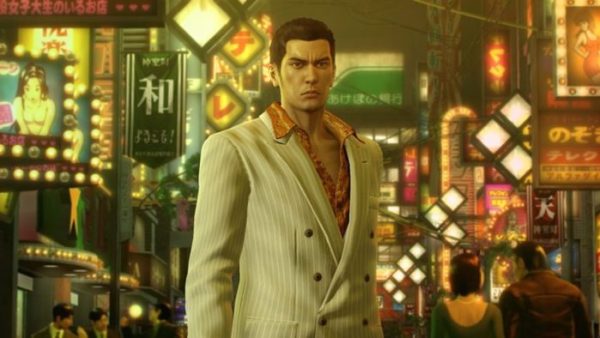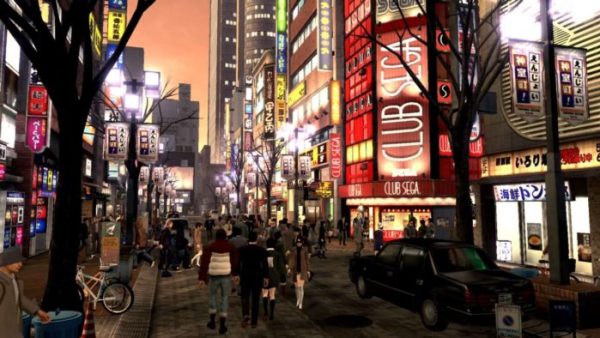There are plenty of memorable locations in video games, places we love exploring and spending time in. Whether it’s Hyrule from The Legend of Zelda or The Citadel in Mass Effect, so many games fill us with memories of their wondrous locales. Despite this fact, rarely do we see a game series that truly shows a location evolving and changing. This is something that the Yakuza series does an exceptionally good job of, and its main city Kamurocho is as important to to the franchise as its main character, Kazuma Kiryu.
Ever since the first Yakuza game’s original release in 2006, we’ve been exploring Kamurocho as the main location in almost every single Yakuza game. For those who might not be aware, Kamurocho is actually based on the real red-light district of Tokyo, Kabuki-cho. The city in the Yakuza games is painstakingly modeled after Kabuki-cho, with different building names and changes to the layout, of course. Still, the similarities are striking and there are some impressive videos you can find detailing that fact.
The most amazing part of this is how the series has shown Kamurocho growing and changing through the years. There are few series that really show us how a location advances through decades, but Yakuza does just that. Our earliest look at the city comes in Yakuza Zero, set in 1988. In that game, Kamurocho is lit with the gaudy gold and neon of Japan’s Bubble Economy. People in flashy suits and dresses flock the streets, people hand out tissues on every street corner, and disco and hostess clubs are a dime a dozen. Something obviously missing from Yakuza Zero is the gigantic Millennium Tower, the centerpiece of Kamurocho from the first Yakuza and on. Instead, Yakuza Zero populates the area with a bunch of dive bars and alleyways, indicative of the time period.
We then see Kamurocho evolve through the 90s and 2000s, losing the disco clubs in favor of pachinko parlors, new restaurants, expanded arcades, and more. Through each game, however, the layout of Kamurocho stays the same. Other video games display change through drastic overhauls to their locales, like how The Elder Scrolls or Fable take big time skips to show a new era. Yakuza instead takes small steps, changing a few locations, or adding something new into the mix. Each entry reveals just a little more of the city, for example Yakuza 4 lets you roam the rooftops and underground areas, and even Yakuza Dead Souls provides more insight into the city by letting you explore blown out buildings that you’ve never been in before.

The landscape also changes with the society and culture of Japan. West Park, at the top right of the Kamurocho map or northeast of the city is a homeless haven in Yakuza Zero. By Yakuza 3, this location has changed drastically and is under construction as the enormous shopping mall, Kamuro Hills. After the course of even one Yakuza game, you’ll come to know Kamurocho like the back of your hand, and jumping into another game in the series, that stays exactly the same. The landmarks stay the same, you know where the Millennium Tower is, you know how to get to the Champion District or Theatre Square, but the sights between those landmakrs change. There’s something comforting about the familiarity of Kamurocho, and jumping back into the city is like seeing an old friend, even as it changes around you with each subsequent entry.
The locations and sights aren’t all that evolve, as the citizens of Kamurocho go through drastic change as well. Every Yakuza game is filled to the brim with side stories to complete, and NPCs to talk to. Many of these are indicative of the time period, like Yakuza Zero having you do a dance battle against Michael Jackson or compete in Pocket Circuit Races with toy cars. Many of these stories carry over into later games, like when you meet someone posing as Kiryu in Yakuza 2 and then run into the Fake Kiryu again in Yakuza 4.
The substories in Yakuza games help give flavor to the town and they’re often incredibly quirky, like Kiryu helping a dominatrix learn how to be more assertive or helping a former assassin get a real job. Many of the substories are themed around why people chose to live in Kamurocho and the hardships that come with living there. On top of this, NPCs talk about the latest trends, their own personal problems, or even basic things like that cake at Cafe Alps that they’ve really been craving.
Yakuza games often like to call back to older side content in past games, and that only helps compound the sense of time passing that the series already gives. With the impending release of Yakuza 6 we’ll be seeing the most modern take on Kamurocho yet, as the game is set in 2016. From what we’ve seen of the game so far, the visual upgrade looks amazing.

Ads and electronic screens are littered around the city, while people go about their daily lives. The key change with Yakuza 6 is that everything is seamless now, meaning there are no loading screens when you step into a restaurant or shop, or even when you get into a battle. This really adds cohesion to Kamurocho, making it feel like a full city, and adds an interesting new layer of exploration inside certain buildings. There’s a few new sights to see as well, with the gym Rizap taking over where Mach Bowl used to be and an adorable cat cafe called Nyan Nyan Cafe put into the city.
Substories return again in Yakuza 6 with just as ridiculous of themes, like Kiryu downloading an all too smart AI helper on his phone named Hiji. You’ll also have access to a new app called Troublr that sends you updates about people in trouble around the city. You can accept these requests and rush to save the person in danger, or ignore them if you want. Another new feature lets Kiryu take pictures and selfies with his phone, and the citizens of Kamurocho will react to it. Some people will pose to be in the photo with you, others will look at you in judgement or try to hide their face. It’s little details like this that make Yakuza 6’s Kamurocho come alive.
Kamurocho is a storied location in video games, with history that you can clearly see play out. It’s really a rare thing in video games to get a location that’s so meticulously built, and then changed over the course of a number of years. Despite Kamurocho being the same place with the same layout, it always feels like something new when you start up a Yakuza game. Kazuma Kiryu’s fate is inexplicably linked to the flashy red-light district, and the two go hand in hand. You can’t have Yakuza without Kamurocho, and the city really is a living, breathing character in and of itself.
